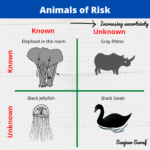Evaluation of reactive chemical hazards can range from simple paper-based calculations to highly complex testing and modeling. This post is aimed to help you formulate a systematic strategy for evaluating reactive chemical hazards in your facility. I will divide the various approaches in three tiers – simple to complex.
Tier I . Theoretical Screening
At the onset, you should try to answer the question – Is there potential reactive chemistry?
To answer this question you can make use of variety of tools:
- functional groups indicative of reactivity hazards
- using group contribution method to estimate energy of reaction
- develop incompatibility matrix
- reactivity data avaiable through MSDS or Bretherick’s Handbook
Tier II. Experimental Screening
Experimental screening involves the conduct of experimental tests to gauge the thermal hazard of materials and processes. The goal of these tests is to verify theoretical values identified previously as well as provide additional information by which the materials and processes may be characterized.
Experimental screening can be divided into three different areas of concern,
- Reactivity: DSC, DTA, TGA
- Mechanical sensitivity: Drop weight test, blasting cap test
- Thermal sensitivity: DSC, DTA, TGA, Konen test
Differential Scanning Calorimetry (DSC) is the work-horse of the industry in determing thermal sensitivity and reactivity.
Tier III. Detailed Testing and Modeling
Experimental analysis involves the conducting thermal hazard analysis tests to verify previous results as well as identify reaction rates and kinetics. The goal of this level of testing is to verify calculated and experimental results and provide additional information by which the materials and processes may be characterized.
Detailed testing is usually conducted using advanced calorimeters such as
- Advanced Reaction Calorimeter (ARC) from TIAX
- Automated Pressure Tracking Adiabatic Calorimeter (APTAC) from TIAX
- Vent Size Package (VSP) from Fauske and Associates
These tests generate data for input into the development of a kinetic model.
By combining experimental data and kinetic model, one can now predict behavior of the reactive system with confidence.



